The Vasa Museum opened in 1990 to display the Vasa, an impressive warship that sank on its maiden voyage in 1628. The ship was recovered in the early 1960s and is now one of the most popular attractions in Stockholm.
History of the Vasa

Construction
In 1625 King Gustav II Adolf, member of the Vasa dynasty, commissioned the construction of four new warships, of which the Vasa would be the first one.
It was the largest ship ever built in Sweden, and the Vasa was meant to be the pride of the marine. Construction of the galleon started the following year at the naval shipyard – now the Blasieholmen neighborhood – where about three hundred men built the ship in a span of less than three years.
The Vasa Disaster
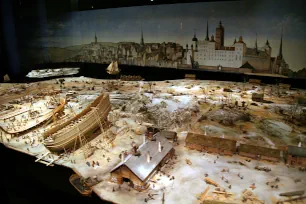
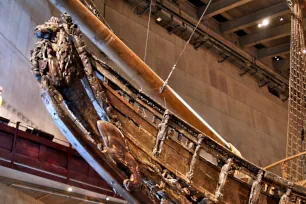
On August 10, 1628, a large crowd gathered near the quays to see the Vasa depart from Slussen for its maiden voyage. It was headed towards the marine base of Älvsnabben, where three hundred soldiers would board the ship. It would never reach its destination: shortly after hoisting four of its ten sails, the ship started to keel over and water gushed in through the open gun ports. After sailing just 1300 meters (0.8 miles), the ship sunk, taking thirty of a total of one hundred fifty people on board with it.
After the disaster, the captain of the ship was taken into custody, but it soon became clear that the main cause of the disaster lied elsewhere. The ship, although well constructed following proven techniques used by Dutch shipbuilders, was not well proportioned; it was too heavy and too tall for its hull.
The Salvage of the Vasa
Already in the seventeenth century, attempts were made to salvage the ship, but only the cannons were recovered. Over time, the exact position of the disaster had fallen into oblivion.
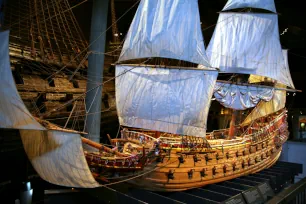
Finally in 1956, after years of searching for the location of the shipwreck, the amateur archaeologist Anders Franzén recovered a wooden piece of the Vasa. The following year the salvage of the Vasa started and tunnels were created for hoisting cables. After years of preparatory work, the Vasa returned to the surface in 1961.
Thanks to the low level of salt in the water, the wooden ship was remarkably well-preserved, since shipworms only survive in water with a minimum level of salt. Nonetheless, there was still an enormous amount of restoration work, not least because thousands of pieces that were recovered had to be identified. The reconstruction of the ship, which is still 95% authentic, continued during the 1990s when the Vasa’s rig was rebuilt.
A New Museum
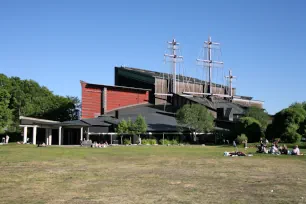
It was clear that such an impressive piece of history deserved its own dedicated museum. Shortly after the Vasa was salvaged, a temporary museum was opened at the Wasa Shipyard. In 1987 the construction of a purpose-built museum for the Vasa started at Djurgården, not far from the site where the Vasa sunk in 1628. Three years later, the Vasamuseet (Vasa Museum) opened to the public.
The building’s exterior, designed by Göran Månson and Marianne Dahlbäck, is clearly inspired by the shape of the giant sailing ship, an image that is reinforced by the three large metal masts at the top of the museum building. They show the full height of the masts of the Vasa.
The Vasa Ship and other museum sights
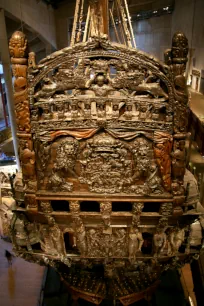
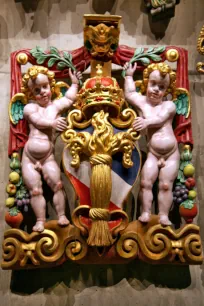
The Vasa was the largest warship of its time; it had 10 sails, carried 64 cannons, had a crew of 145 and could carry 300 soldiers. The ship had a length of about 69 meters (226 ft) and its main mast was more than 52 meters tall. But what makes the ship really impressive is the rich decoration: a total of 500 sculptures and 200 ornaments were created by sculptors, most of whom hailed from Holland and Germany.
The most impressive decorations are the large lion at the ship’s bow and the 19.3 meters high stern (63 ft) which is completely covered with magnificent sculptures. The lion is a reference to king Gustav II, who was known as the ‘Lion of the North’.
Most of the statues on the ship depict figures from Greek mythology and the bible. But there are also depictions of sea monsters, Swedish aristocrats and royal symbols. The original sculptures are now in plain wood colors, but originally they were painted with bright colors. Several replica sculptures as well as a fully painted scale model of the Vasa show how the ship must have looked in 1628.
The ship had a full cargo when it departed on its fatal first journey, and many objects that were recovered are now on display at the museum. They give visitors an idea of life on a large ship during the seventeenth century. Some of the interesting objects include a wooden board game, medical equipment, wooden spoons, tin kitchenware and thousands of copper coins.
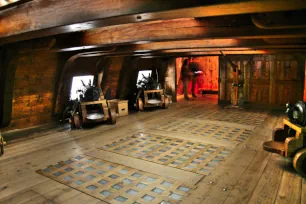
Visitors are not allowed in the ship itself, but a section of the upper cannon deck has been reconstructed. There are many other exhibits in the museum that focus on different aspects of the history of the Vasa, including its construction, the disaster and the salvage of the ship wreck.
Outside the museum building are two early twentieth century museum ships moored along the quay. The ships, the icebreaker SS Sankt Erik and the lightship Finngrundet can be accessed from inside the museum via an elevated ramp.

